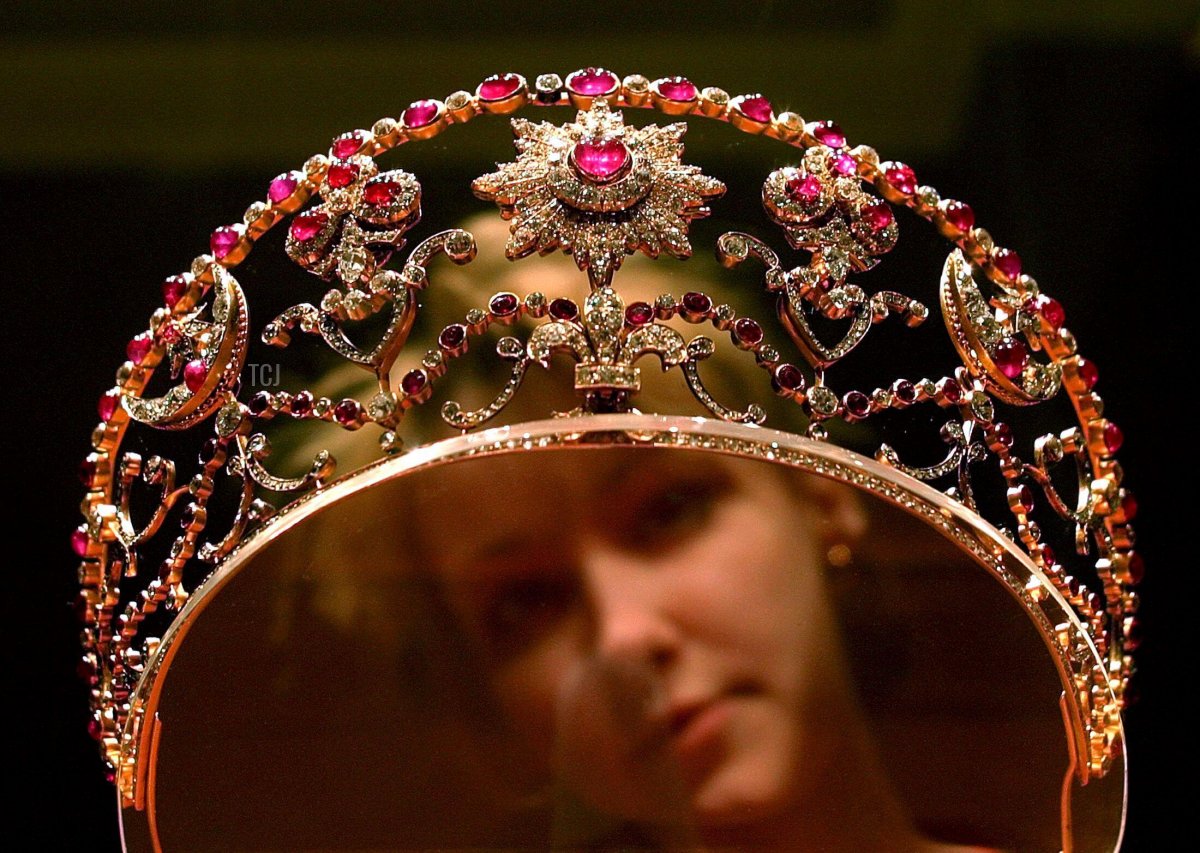
Following the recent death of the Duke of Edinburgh, the history of the Battenberg/Mountbatten family has been a frequent discussion topic. Today, we’ve got a closer look at a tiara that once belonged to a branch of the family—but has since left the family collection. Here’s a bit of history on the Milford Haven Ruby Kokoshnik.
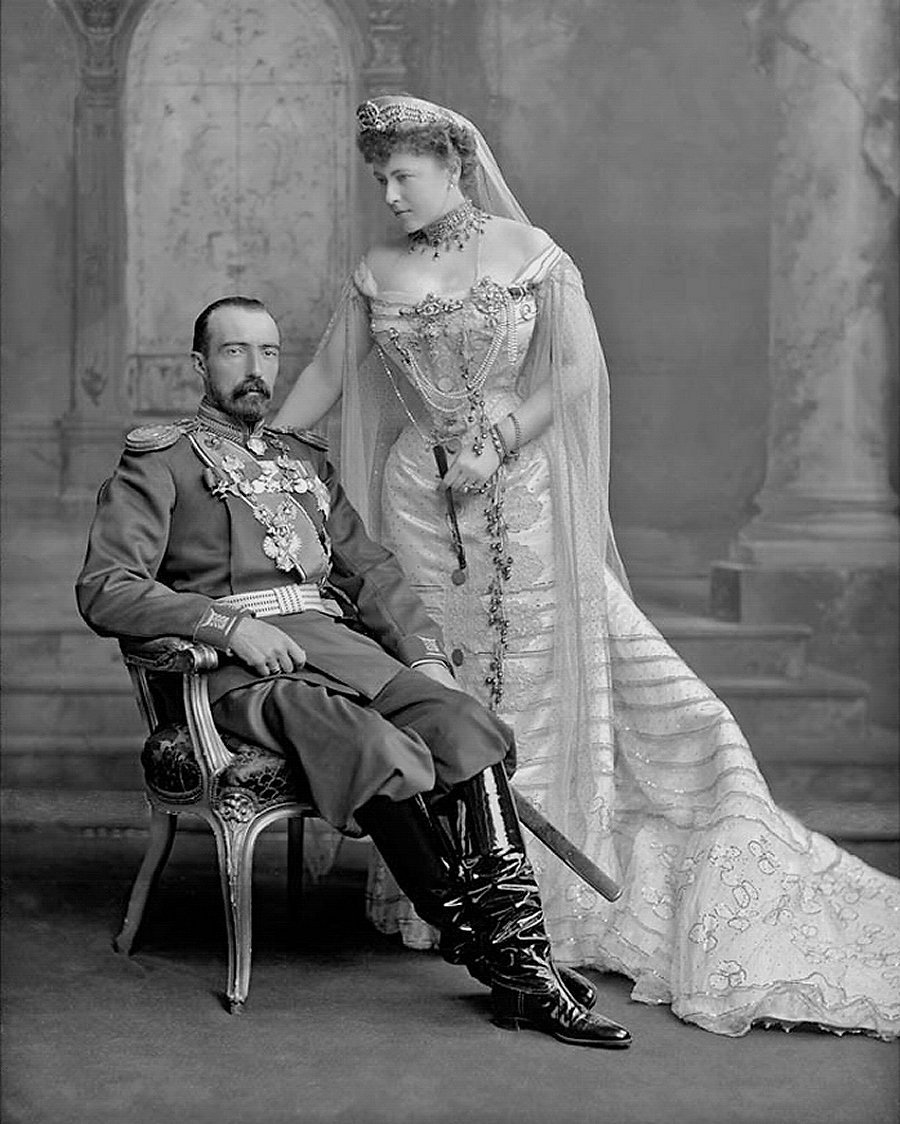
The story of this tiara begins more than a century ago on the French Riviera. Grand Duke Mikhail Mikhailovich of Russia, a grandson of Emperor Nicholas I, met and fell in love with Countess Sophie of Merenberg. Sophie was the daughter of Prince Nikolaus Wilhelm of Nassau, a son of Duke Wilhelm of Nassau and Princess Pauline of Wurttemberg. In 1868, Prince Nikolaos had fallen in love with Natalia Pushkina, the youngest daughter of the famous poet Alexander Pushkin. The two married that year in London, but because they came from unequal social backgrounds, the marriage was classified as morganatic. Nikolaos wasn’t able to share his rank or title with his wife or their children; instead, his brother-in-law, the Prince of Waldeck and Pyrmont, created a new noble title for Natalia and their children, making them Counts and Countesses of Merenberg.
History repeated itself when Grand Duke Mikhail and Countess Sophie met and fell in love three decades later. Like her parents, Mikhail and Sophie were also of unequal rank: he was an imperial highness and a member of the Romanov dynasty, while she was a mere countess (and the product of an unequal union). The couple made a risky move, marrying in secret in Italy in February 1891. The Romanovs, predictably, did not take the news well. Mikhail hadn’t asked his cousin, the tsar, for permission to marry Sophie, knowing it would have been automatically denied.
The reaction from Emperor Alexander III was swift and negative. The Morning Post published an item in April 1891 demonstrating the tsar’s reaction to the wedding: “A telegram from St. Petersburg announces that the name of the Grand Duke Michael Michaelovitch has been removed from the Russian Army List and from the honorary colonelcies of a regiment of the Guards, the 49th Infantry, and the 4th Battery of the Guards Artillery.” He was essentially exiled from Russia for life, only returning briefly to the country a few times for important occasions. Even worse, Mikhail’s mother, Grand Duchess Olga Feodorovna, became seriously ill when she learned of his marriage. She was ordered by her doctors to travel to the Crimea to try to recover her health—and died of a heart attack on the journey. Mikhail was blamed for her death, and he was not permitted to attend her funeral in St. Petersburg.
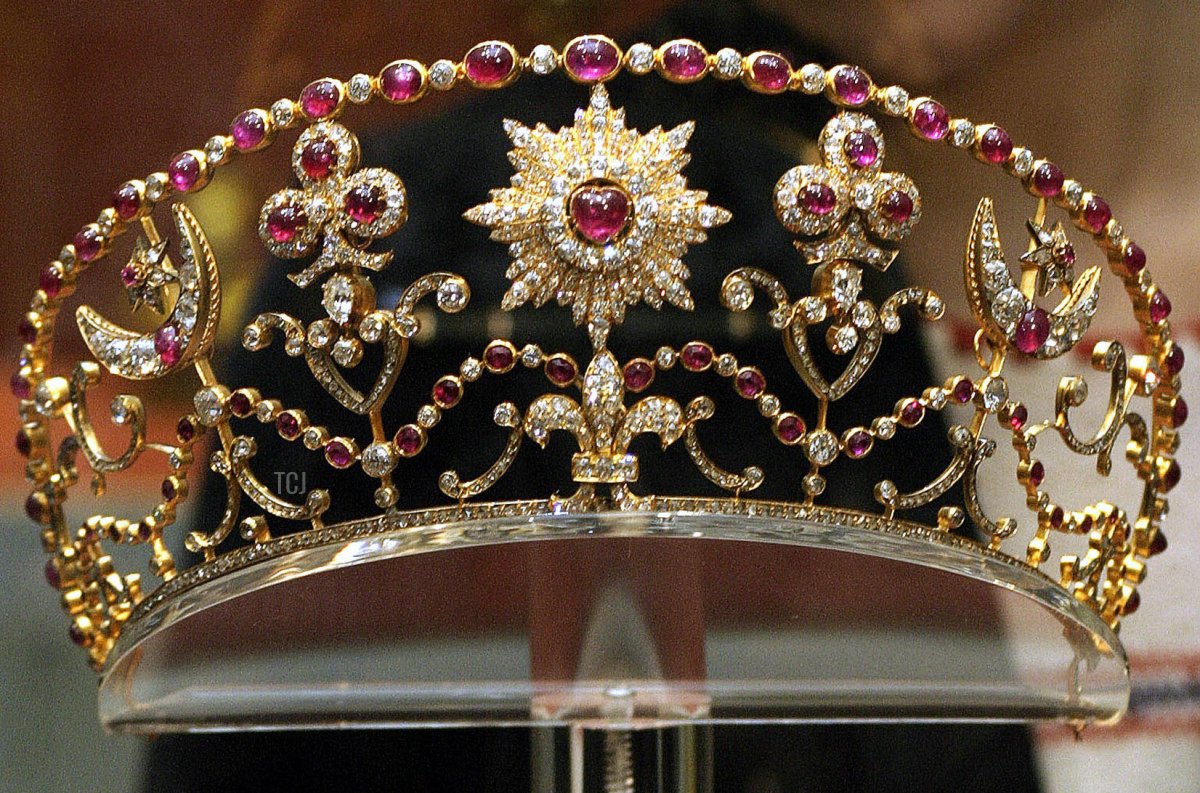
The Russian imperial family may have strongly disapproved of Grand Duke Mikhail’s marriage, but he offered his wife a wedding gift that was certainly fit for a Romanov bride. He presented her with this impressive kokoshnik-style tiara, made of ruby and diamonds set in yellow gold, which features stars, crescent moons, trefoils, scrolls, and hearts in its design. In the center of the piece, a radiant star with a heart-shaped ruby cabochon in its center sits atop a diamond fleur-de-lis. A border of rubies and diamonds runs along the top of the tiara, while a similar row of gems meanders through the center of the piece. Grand Duke Mikhail commissioned the romantic tiara from Bolin’s St. Petersburg branch at the time of the wedding. I’ve read that pieces of the tiara can be removed and worn as brooches; while I’ve not seen the tiara from an angle that would confirm or deny this, it certainly seems plausible.
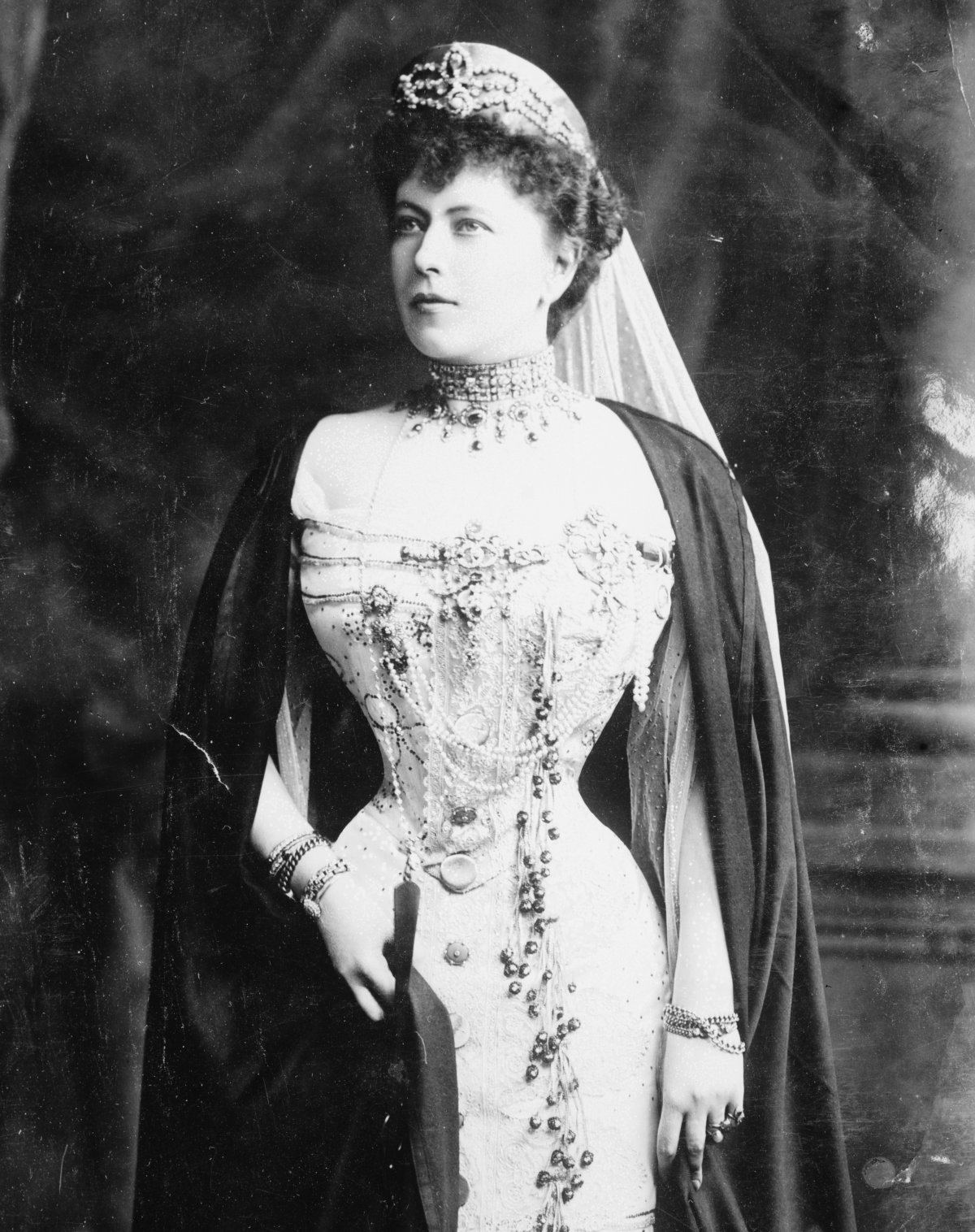
Though Mikhail and Sophie faced incredible pressure at the start of their marriage, they ended up staying together for the rest of their lives. They settled in Cannes with their three children: Anastasia (“Zia”), Nadejda (“Nada”), and Mikhail (“Boy”). Mikhail’s father, Grand Duke Mikhail Nikolaevich, eventually warmed to the couple’s relationship and spent a great deal of time with them in France. (His sister, Grand Duchess Anastasia of Mecklenburg-Schwerin, lived nearby as well.) And, just as had happened for Sophie’s mother a generation earlier, another royal relative stepped in to grant her and her children elevated titles of their own. In August 1892, shortly before Zia’s birth, the Standard reported: “The Grand Duke of Luxemburg has conferred the hereditary title of Countess of Torby on the Russian Grand Duke Michael Michailovitch’s wife, whose accouchement is shortly expected.” (Grand Duke Adolphe of Luxembourg was Sophie’s paternal uncle.)
At the turn of the twentieth century, Mikhail and Sophie began spending a good deal of the year in England. They leased a country home in Staffordshire for a decade, and then moved to Kenwood House near London. They socialized with the British royal family at Buckingham Palace and Sandringham, and they became good friends of King Edward VII. The photographs of the couple in this post were taken in 1902, around the time of his coronation. They later (unsuccessfully) tried to compel King George V to offer a British title to Sophie, prompting George to write to his cousin, Emperor Nicholas II, lamenting “that good fool Michael” and his misplaced ambitions.
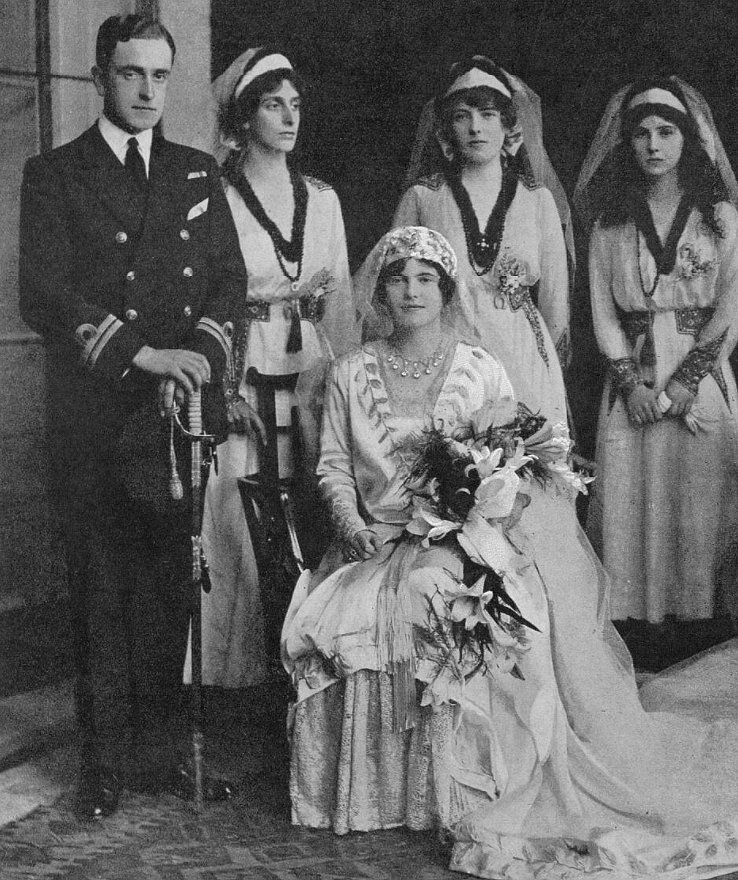
A few years later, however, one member of the family made a match that drew them all closer to the British royals. Mikhail and Sophie’s younger daughter, Nada, married Prince George of Battenberg on November 15, 1916. King George V, Queen Mary, and Queen Alexandra were all present for the wedding, which was held at the Chapel Royal, St. James’s Palace. (The bridesmaids, three of whom are pictured above, were George’s sister, Princess Louise of Battenberg; Nada’s sister, Countess Zia de Torby; and two of Nada’s cousins, Princesses Nina and Xenia of Russia.)
Prince George, the elder son of Prince Louis of Battenberg and Princess Victoria of Hesse and by Rhine, was a member of the extended British royal family. (As a Battenberg, he also came from another noted morganatic royal line.) George’s grandmother was Princess Alice of the United Kingdom, a daughter of Queen Victoria and Prince Albert. George had three siblings, all of whom made their marks on royal history: Alice, who married Prince Andrew of Greece and Denmark and was the mother of the Duke of Edinburgh; Louise, who was Queen of Sweden via her marriage to King Gustaf VI Adolf; and Louis, the naval officer who served as First Sea Lord and Viceroy of India before being created Earl Mountbatten of Burma.
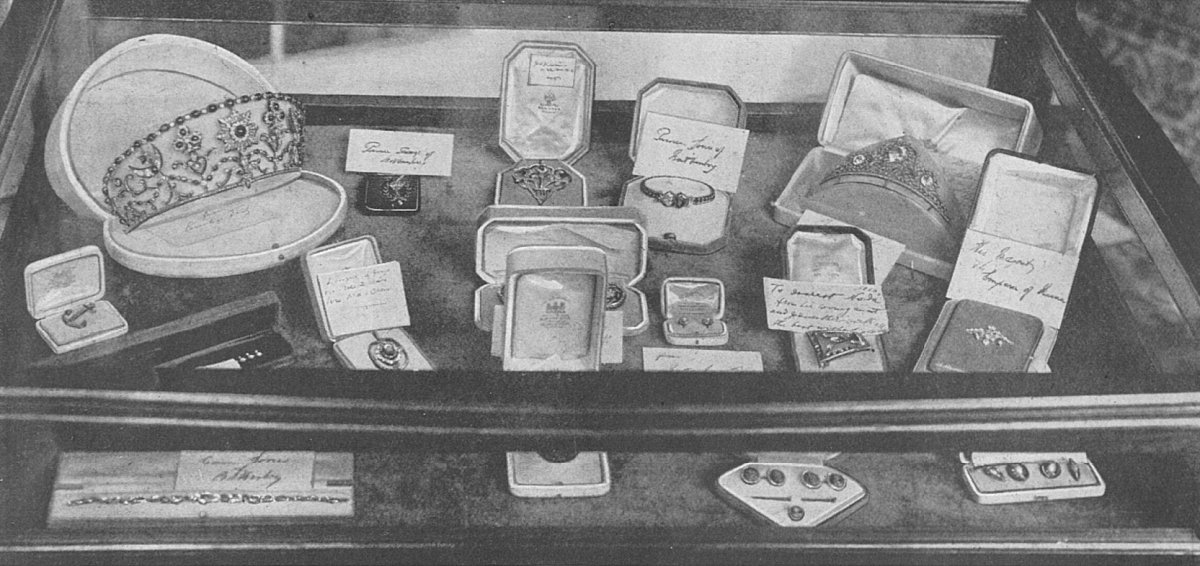
Nada’s bejeweled wedding gifts went on display and were photographed by the British press. As you’ll note in the image above, the jewelry haul included the ruby and diamond kokoshnik, given to Nada by her mother, Countess Sophie. (Her sister, Zia, later reportedly got a copy of the kokoshnik, with sapphires instead of rubies, as a wedding gift.) Also pictured are a diamond and ruby bracelet (fourth from the right), given to her by her father-in-law, Prince Louis of Battenberg, as well as an aquamarine pendant (far right), a gift from Emperor Nicholas II of Russia. A small jewel offered to Nada by her new husband is placed just to the right of the kokoshnik as well. (I’m also of course very intrigued by the second tiara pictured, though the inscription on the card isn’t legible.)
Along with a collection of new jewels, the marriage gave Nada a new royal title, HSH Princess George of Battenberg—for a little while, at least. In 1917, as World War I raged on in Europe, King George V asked Prince George’s father, Prince Louis of Battenberg, to relinquish his German titles. (Though he had been born a German prince, Louis was a decorated officer in the British navy who had risen to the highest rank, First Sea Lord, in 1912.) Louis obliged, taking on the anglicized surname of “Mountbatten.” King George rewarded Louis in November 1917 with a new hereditary title, Marquess of Milford Haven. George and Nada, in turn, lost their royal titles but became the Earl and Countess of Medina.
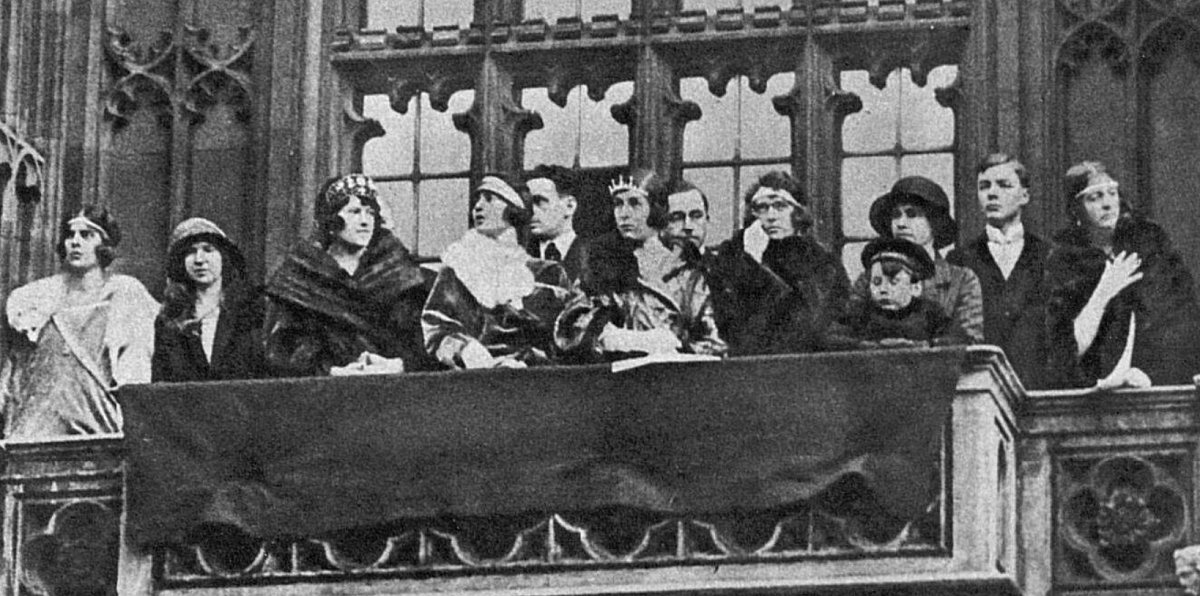
After the death of George’s father in 1921, he and Nada became the Marquess and Marchioness of Milford Haven. Three years later, in January 1924, Nada was pictured wearing her mother’s ruby kokoshnik at the State Opening of Parliament. The Westminster Gazette reported that she paired the tiara with “an all-gold tissue gown,” topped by a fur to ward off the wintry cold weather. In the photo above, Nada is wearing the tiara; she’s the third person from the left.
This picture of the Milford Havens on a balcony was taken on the day of the state opening, and it features several other members of their family and some of their friends. Included here are Nada’s sister, Zia, and her husband, Sir Harold Wernher; the Countess of Airlie; and two of George’s nieces, Princesses Margarita and Theodora of Greece and Denmark. (The Westminster Gazette reported that Margarita was with Nada when they arrived at the Houses of Parliament, wearing “orchid-mauve crepe, without trimming or jewels.”) George and Nada’s young son, David, also appears to be present on the balcony with a nanny.
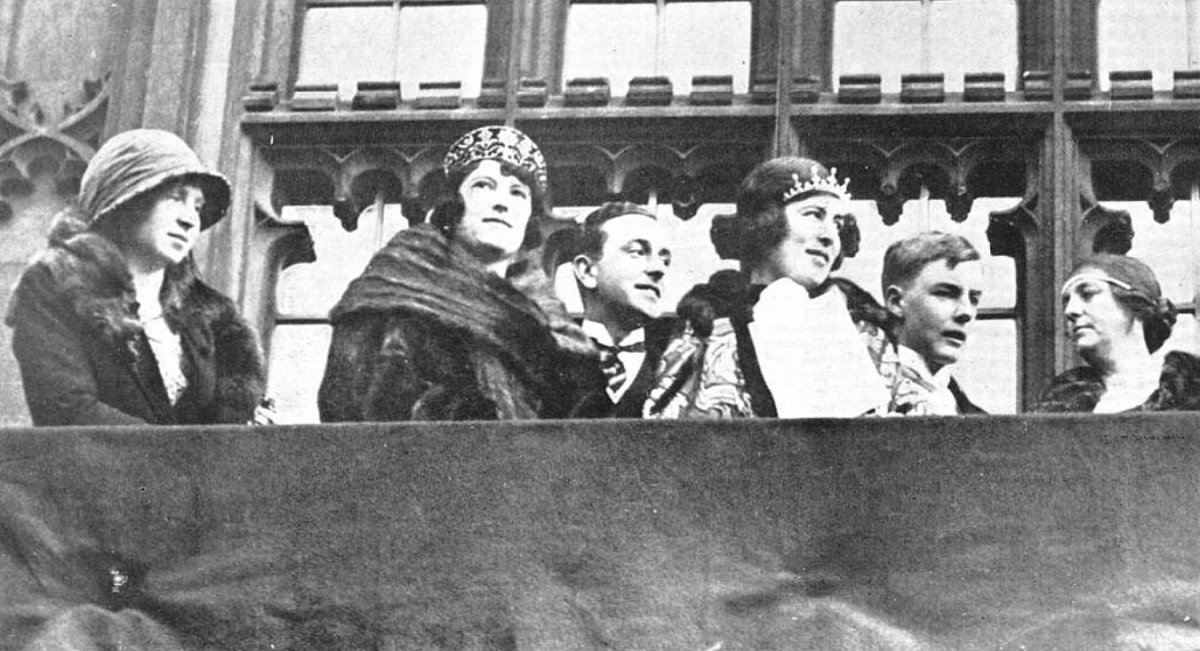
Here’s another photo of the same balcony appearance from a slightly different angle. Nada wears the kokoshnik tiara low across her forehead, a style that was popular during the 1920s. She continued to wear the tiara at official functions throughout her lifetime, including the coronation of King George VI and Queen Elizabeth in 1936. Sadly, though, her marriage was not a long one. In 1938, George died of cancer at the age of only 45.
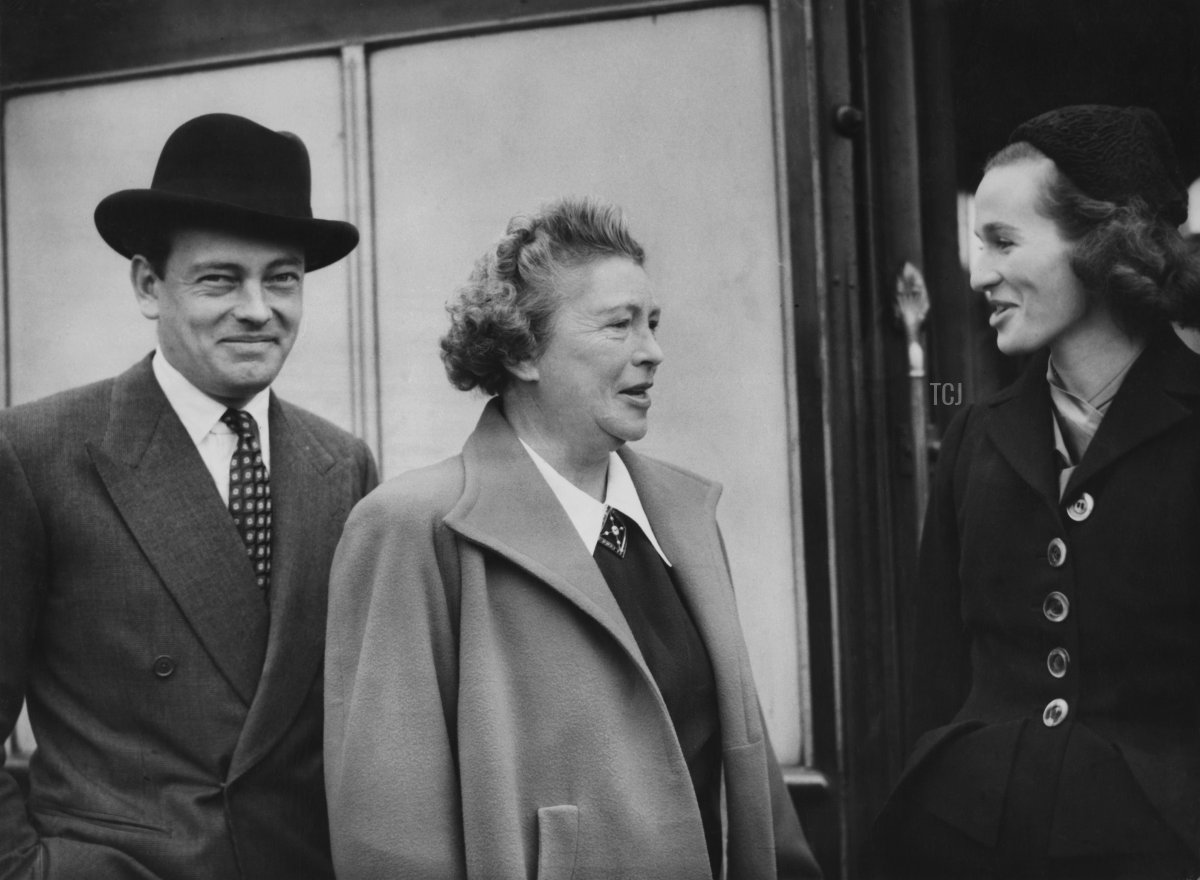
Nada never remarried; she died in Cannes, her birthplace, in 1963. The Milford Haven marquessate had passed to her son, David, in 1938; he also inherited the ruby kokoshnik. Above, David and Nada are pictured with his first wife, Romaine Dahlgren Pierce, in November 1949.
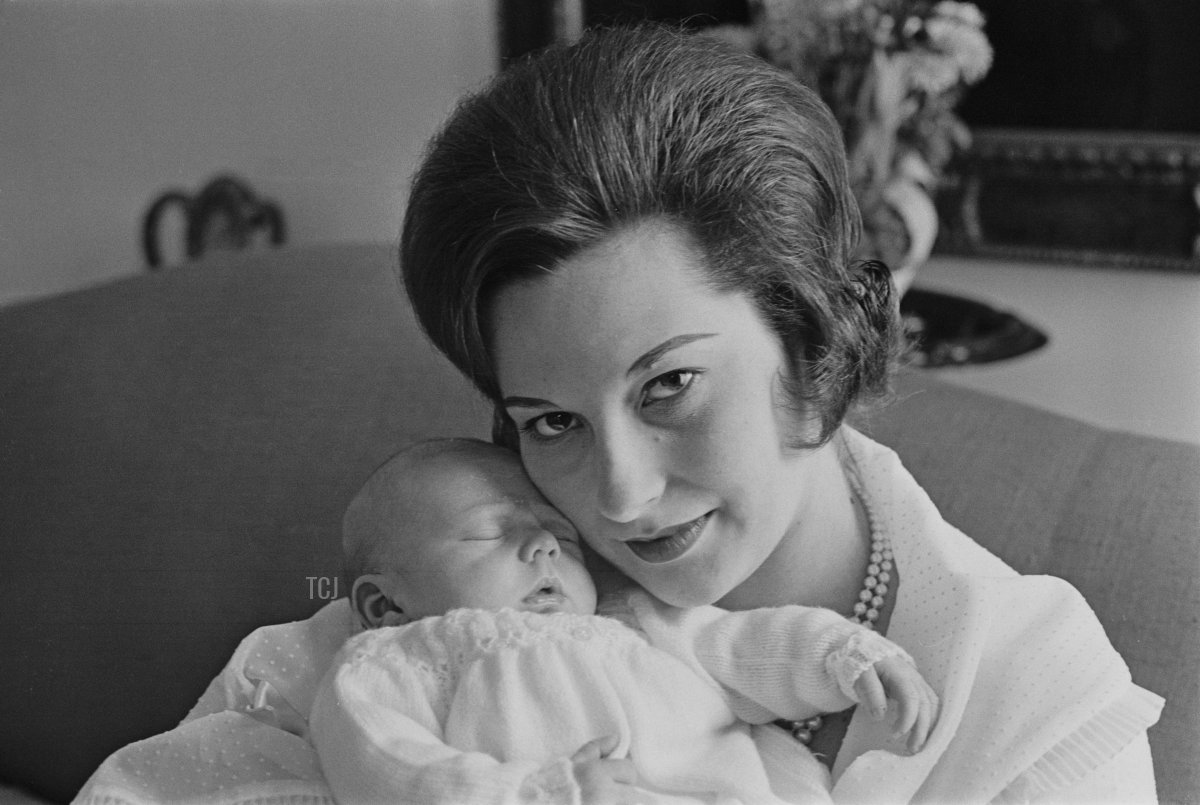
After his divorce in 1954, David married for a second time to Janet Mercedes Bryce. Neither of his wives wore the kokoshnik for their weddings. Janet and David had two children: George, who would become the 4th Marquess of Milford Haven on David’s death in 1970, and Ivar, pictured above as a baby with his mother.

With the Milford Haven title, George also inherited the ruby and diamond kokoshnik. The most recent images of the tiara on a family member were taken in 1994, when George’s brother, Lord Ivar Mountbatten, married Penelope Thompson. (She wore the tiara for the ceremony; you can see an image here. Ivar and Penny divorced in 2011, and today he’s married to James Coyle.) For years, there has been speculation about where the tiara is now, and I’m pleased to say that I can clear up that mystery somewhat today.
Like his father before him, George Milford Haven has been married twice. His first wife, Sarah Walker (pictured above with partner Michael Spencer in 2013), was the daughter of the owner of Brent Walker, a British company that owned various entities (including betting shops and bookmakers, pubs, shopping centers, and beverage companies). The Milford Havens were rich in connections and history but fairly poor in cash. The 1989 Walker marriage helped to bolster the family financial portfolio, which included an estate called Moyns Park, an Elizabethan-era country house that George and Ivar had jointly inherited through their mother’s family. But then Brent Walker collapsed in the early ’90s, causing major financial strife for the Walker family—and, by extension, for George and Sarah. Ivar ended up buying out his brother’s share in Moyns Park, becoming the sole owner of the house. (Ivar and Penny ended up selling it in 1997.)
Financial problems for the Milford Havens led to marital problems, too. Though Sarah’s wealth would eventually be restored, the emotional damage to their relationship was not able to be repaired. They separated in 1994, and by 1996, they had finalized their divorce. A year later, George married his second wife, Clare Wentworth-Stanley. George and Clare are pictured above at the Cartier Queen’s Cup Final in 2016. (Because this is an exceptionally small world, it’s worth noting that Clare’s son, Harry Wentworth-Stanley, is married to Cressida Bonas, ex-girlfriend of the Duke of Sussex.)
In 1996, after the divorce, Sarah Milford Haven gave an interview to Hello! about her former marriage and the family estate. She revealed that, though Moyns Park had been sold to Ivar and Penny, the Milford Haven jewels (including the kokoshnik) had remained with George and Sarah. But, as George’s own financial issues became overwhelming, Sarah had stepped in to provide more help. “When George had financial problems my trust bought the Milford Haven jewellery collection, including the tiara which my sister-in-law Penny wore at her wedding,” she revealed, adding that she intended the jewels to be inherited by their son, the Earl of Medina, thereby keeping them in the family. (Meanwhile, Sarah’s sister, Eastenders actress Romla Walker, wore the tiara for her own wedding.)
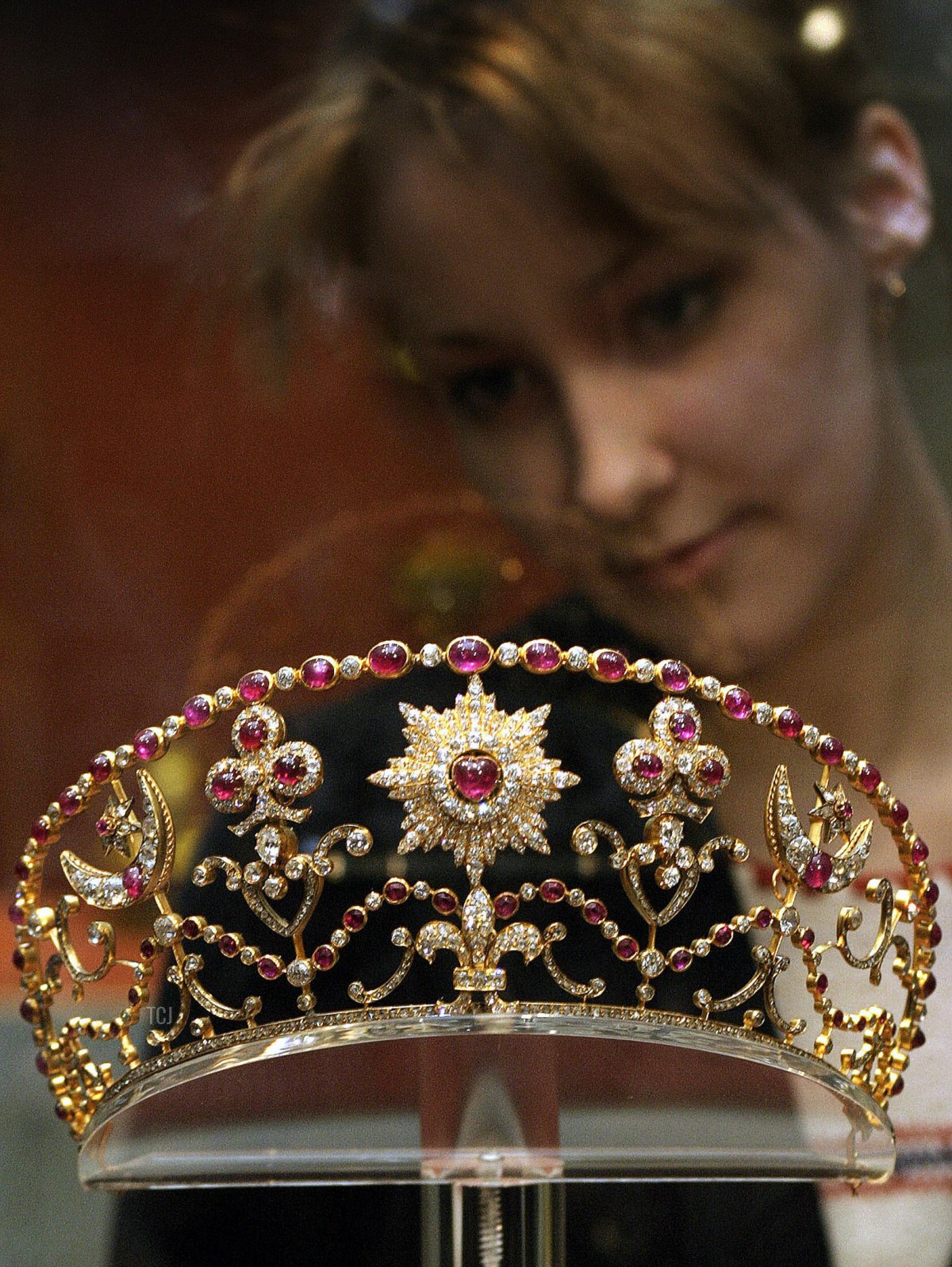
Except, sadly, that’s not at all what happened. In March 2004, the tiara was put on display at the Hermitage Museum in St. Petersburg. The Sunday Times reported that Sarah was planning to sell the tiara, with Russian businessman Artem Tarasov acting as a sort of broker. Sarah’s sister, Romla Walker, told the Times, “I have known Tarasov for years and trust him. Sarah is selling the tiara because it has no emotional value. Most of the time it’s on loan around the world.” The statement about the lack of emotional value is a sad one, given the tiara’s links to two of the Milford Haven family’s most important historical couples. But, thanks to Sarah and George’s divorce, perhaps it’s also somewhat understandable. (Also: how did the Walkers know Artem Tarasov? It may have helped that Sarah and Romla’s father, George Walker, was reportedly spending a significant amount of his time in Moscow.)
An article published in the Vancouver Sun in April 2004 revealed, “Last month Tarasov arranged the transport from England to St. Petersburg of an 1890 tiara made by the court jewellers Bolin & Company,” adding that when “the tiara’s current owner, Sarah, Marchioness of Milford Haven, decided to sell the family heirloom, Artem Tarasov convinced her to look for a Russian buyer before offering the tiara on the open market. Tarasov arranged to bring the diamond and ruby tiara to the Hermitage Museum last month where it went on display in the institution’s maximum security Diamond Gallery in what amounted to a two week sales promotion.”
A buyer apparently was indeed found. By May 2004, the Associated Press was reporting that a sale had been finalized. “A Russian businessman living in Latvia has purchased a royal crown that once belonged to the Romanov dynasty,” they noted, “and will return it to Russia, according to the bank that safeguards the item.” It appears that the tiara has officially gone to live where Grand Duke Mikhail and Countess Sophie could not: in Russia. To my knowledge, we haven’t seen a photograph of the piece since the display and sale in 2004, nearly two decades ago.
As a post-script: in an interesting twist of fate, George Milford Haven ended up gaining a fortune of his own. In 2006, he sold a web company that he had founded in 2000 for a cool £210 million. Too bad he hadn’t had that cash available when the family’s heirloom tiara was on the market…
Huge thanks to Marlene Koenig, an expert on the descendants of Queen Victoria, for contributing source material to this article. Visit her website, Royal Musings, to explore her royal reporting and writing.
Leave a Reply
You must be logged in to post a comment.